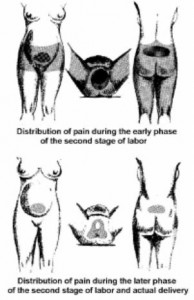a. Patient’s Pelvic Anatomy Itself.
If the patient’s pelvic anatomy is large, it may be easily expandable and if it is small, more stretching and increased intraabdominal pressure may be required.
b. Fetal Head Size.
A large head would require more room and more time to descend and deliver. A small head may pass through the pelvis with a minimal amount of stretching.
c. Strength, Frequency, and Duration of Uterine Contractions.
(1) Extremely strong contractions may cause significant discomfort to the patient.
(2) Contractions occurring every two to three minutes may cause the patient to be fatigued and less tolerable of the discomfort.
(3) Contractions continually lasting sixty to ninety seconds require a great deal of tolerance and concentration by the patient.
d. Presence or Absence of Certain Obstetrical Deviations or Complications.
The need for induction may result in longer, harder labor than if labor was spontaneous. Problems with the fetus in utero may preclude the patient from receiving any type of sedation.
e. Patient’s Pain Threshold.
It is believed that the pain felt may be altered by the level of available morphine-like hormonal substances in the body called endorphins. Endorphins are a special protein. They appear to interfere with transmission of pain producing impulses to the brain or may interfere with the brain’s sensitivity to these impulses. Endorphin levels decrease in the presence of anxiety, tension, fatigue, and extended negative stimuli.
NOTE: See figure 4-1 for areas of pain.

